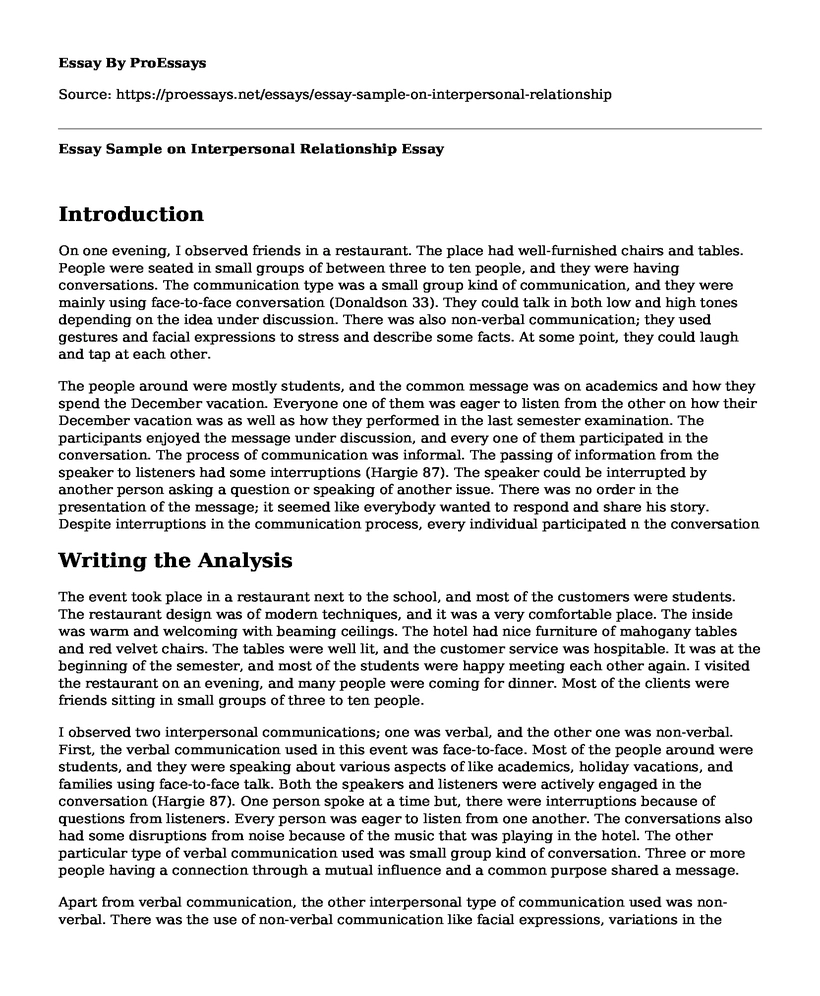Introduction
On one evening, I observed friends in a restaurant. The place had well-furnished chairs and tables. People were seated in small groups of between three to ten people, and they were having conversations. The communication type was a small group kind of communication, and they were mainly using face-to-face conversation (Donaldson 33). They could talk in both low and high tones depending on the idea under discussion. There was also non-verbal communication; they used gestures and facial expressions to stress and describe some facts. At some point, they could laugh and tap at each other.
The people around were mostly students, and the common message was on academics and how they spend the December vacation. Everyone one of them was eager to listen from the other on how their December vacation was as well as how they performed in the last semester examination. The participants enjoyed the message under discussion, and every one of them participated in the conversation. The process of communication was informal. The passing of information from the speaker to listeners had some interruptions (Hargie 87). The speaker could be interrupted by another person asking a question or speaking of another issue. There was no order in the presentation of the message; it seemed like everybody wanted to respond and share his story. Despite interruptions in the communication process, every individual participated n the conversation
Writing the Analysis
The event took place in a restaurant next to the school, and most of the customers were students. The restaurant design was of modern techniques, and it was a very comfortable place. The inside was warm and welcoming with beaming ceilings. The hotel had nice furniture of mahogany tables and red velvet chairs. The tables were well lit, and the customer service was hospitable. It was at the beginning of the semester, and most of the students were happy meeting each other again. I visited the restaurant on an evening, and many people were coming for dinner. Most of the clients were friends sitting in small groups of three to ten people.
I observed two interpersonal communications; one was verbal, and the other one was non-verbal. First, the verbal communication used in this event was face-to-face. Most of the people around were students, and they were speaking about various aspects of like academics, holiday vacations, and families using face-to-face talk. Both the speakers and listeners were actively engaged in the conversation (Hargie 87). One person spoke at a time but, there were interruptions because of questions from listeners. Every person was eager to listen from one another. The conversations also had some disruptions from noise because of the music that was playing in the hotel. The other particular type of verbal communication used was small group kind of conversation. Three or more people having a connection through a mutual influence and a common purpose shared a message.
Apart from verbal communication, the other interpersonal type of communication used was non-verbal. There was the use of non-verbal communication like facial expressions, variations in the voice pitch and tone, and gestures. Non-verbal communication was for the reinforcement of the spoken messages. Firstly, gestures were for the description purposes where the speaker expresses the idea to the audience by moving parts of the body like hands. Facial expressions, on the other hand, were used to stress on emotions and feeling of both the speaker and listener in responding to the subject under discussion (Donaldson 33). Lastly, the variations of tone and pitch helped in showing the meaning of the spoken words to listeners. The use of non-verbal communication generally showed the kind of relationship that existed among the people involved.
From the observation, I discovered some aspects of interpersonal communication. One of the identified issues was on the effectiveness of the communication. I noted that conversation was not effective because the process of communication had disruptions. Speakers were interrupted by listeners who were asking questions in the middle of the speech (Hargie 87). Listeners were not patient to wait for the completion of the statement by the speaker. The communication was not orderly as every person wanted to talk at the same time. This kind of communication can result in conflicts and weaken the relationship between the people involved. Therefore, there is a need for order to allow each person gets an opportunity to speak or ask questions.
Communication was also not effective because of the noise. The place was noisy as it had the music playing as well as other people talking loudly. As a result, the communication was interrupted because of the poor choice of the venue. Since the communication involved a small group in a one-on-one conversation, they would have chosen a place with less interruption from music or other people. The listening skills of listeners were also poor as they did not concentrate on the idea under discussion. Poor listening skills led to incidences of the listeners asking unnecessary question after clear illustrations by the speakers (Donaldson 33). Concerning speaking skills, people delivering the message were audible and clear.
Works Cited
Donaldson, E.L. "Interpersonal Communication". Canadian Journal Of Communication, vol 19, no. 2, 2016. CISP Journal Services, doi:10.22230/cjc.1994v19n2a815.
Hargie, Owen. Skilled Interpersonal Communication. Routledge, 2017.
Cite this page
Essay Sample on Interpersonal Relationship. (2022, Nov 10). Retrieved from https://proessays.net/essays/essay-sample-on-interpersonal-relationship
If you are the original author of this essay and no longer wish to have it published on the ProEssays website, please click below to request its removal:
- Evaluation Essay on Institute for Global Ethics
- Organizational Communication Barriers: Challenges in Businesses - Research Paper
- Bussing Program Beneficial to Unrepresented Minorities: Rose Place Case Study
- Essay Sample on Amish: Working Together for Unity & Stability
- Racial Segregation: Restricting Policies of US and Its Impact on African Americans - Essay Sample
- Essay Example on Banyamulenge Accused of Plotting to Oust Mobutu in DRC Crisis
- Research Paper Example on Teen Pregnancy: Global Issue with Disadvantaged Societies







